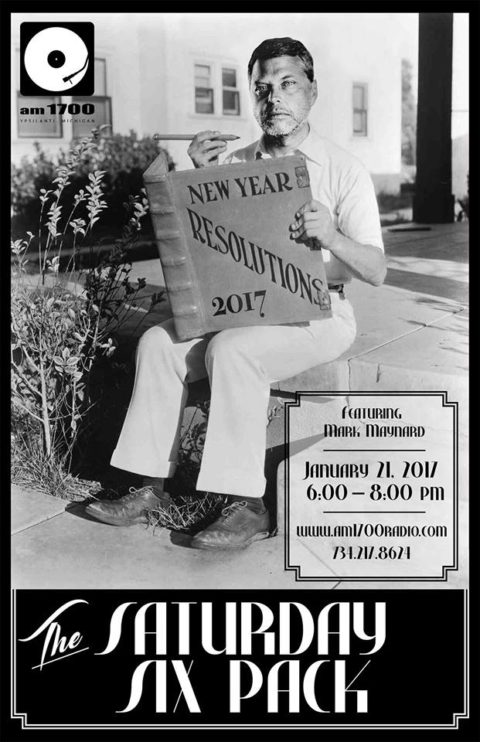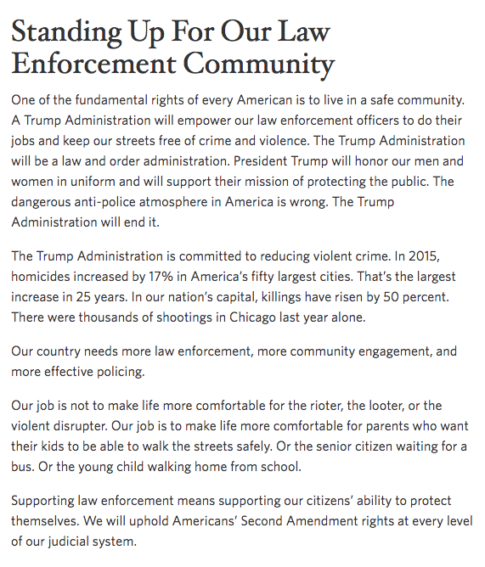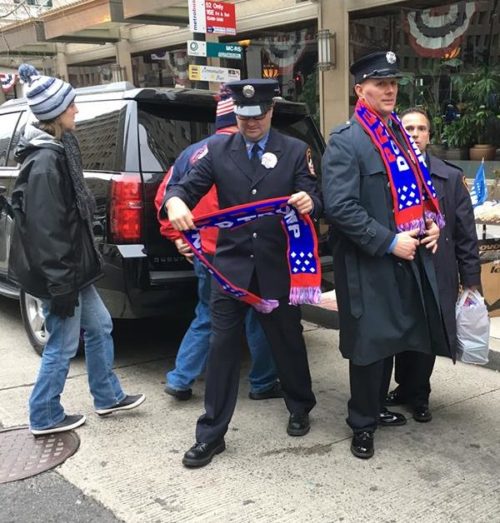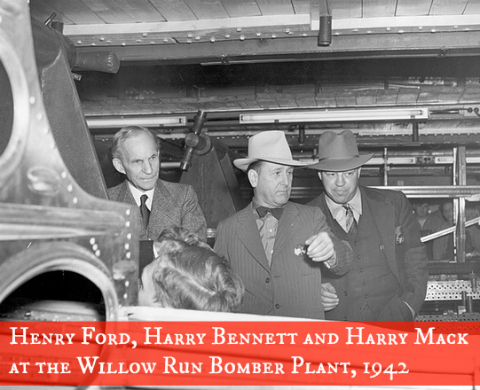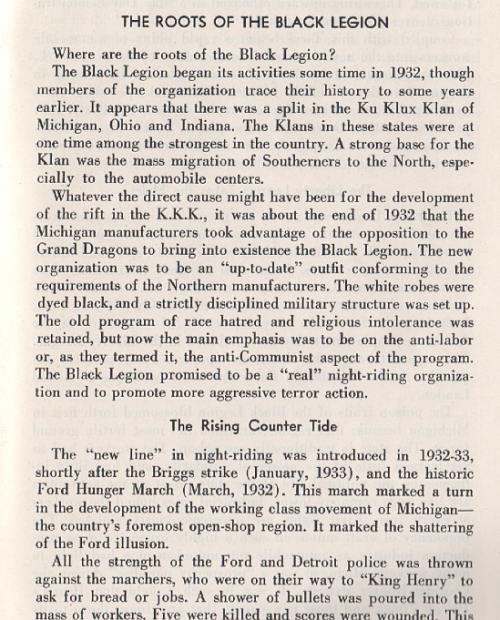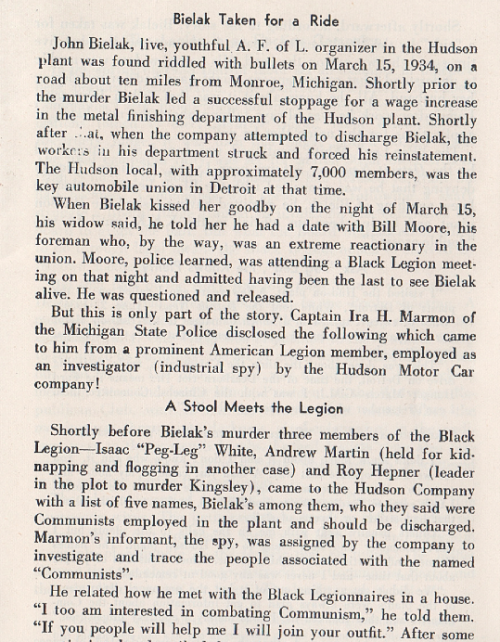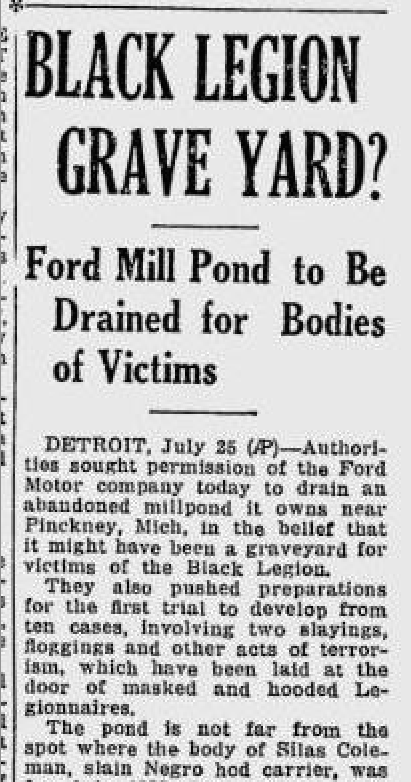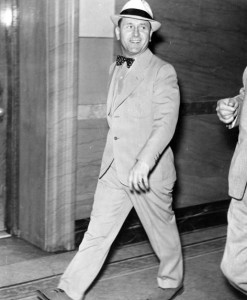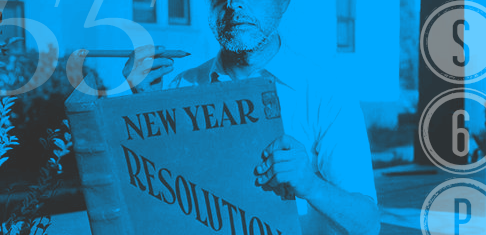
This weekend’s episode of the Saturday Six Pack, our first under the Trump administration, will be told in two parts.
First, we will be talking with people on the ground in D.C., and elsewhere, about the response to the Trump inauguration, with special emphasis on how women are standing up and letting it be known that they intend to fight to protect their rights, safety, health, and families. We’ll be talking on the phone with Congresswoman Debbie Dingell about her experiences at the Women’s March on Washington, which will have concluded just as our show is starting. And State Senator Gretchen Whitmer, who just recently announced her run for Governor, will be calling in to talk about the Women’s March on Lansing, where she will have just delivered the headline address. And, on the local front, we’ll have organizer Desirae Simmons with us in the studio, discussing the Ypsi March for Love, Resilience and Action. [The Ypsi march, if you’d like to join, is scheduled to get underway Saturday at noon, at the intersection of North Washington Street and Michigan Avenue.] And, as if that we’re enough, we’ll also be taking as many calls as we can from friends, family, and Saturday Six Pack listeners around the country about how they spent their first full day under the Trump administration, marching, resisting, and hatching plans for the future. So, if you weren’t lucky enough to score a bus ticket to D.C., tune in and join us for what I hope will be a long series of conversations with women, both young and old, about how they intend to spend the next four years. And do feel free to call in and join us, if you’d like for your voice to be among those collected in this audio time capsule marking the official beginning of the fight against Trump. [If you’re going to call, we’ll be opening up the lines between 6:30 and 7:15.]
It’s something that we’ve discussed here before, but it’s probably worth repeating… In spite of Trump’s long track record of misogyny, and the fact that we’ve all heard him say on tape that his celebrity status entitles him to “grab” women “by the pussy” without their consent, a significant number of women in this country voted for him to be their President over Secretary Clinton, the first female major party candidate for president in United States history. While 94 percent of black women, and 68 percent of Hispanic women voted for Clinton, a staggering 53 percent of all white women voted for Trump. [51 percent of all college-educated white women, and 62 percent of all white women without college degrees, voted for Trump.] It’s one of the most interesting things to me about this last election, and it’s one of the big reasons I’m as enthusiastic as I am about events like the Women’s March on Washington, which are striving to bring women together to discuss these vitally important issues.
While some, as you might expect, are playing up the abortion divide, suggesting that it might kill any chance of a women’s movement that extends beyond already established political boundaries, I’ve got to think there’s still potential here. Even women who voted for Trump, I’ve got to think, have to be concerned about things like access to birth control, quality healthcare and sexism in the workplace, even if they felt more strongly about other issues during the election. And I suspect there are going to be innumerable opportunities for women to find common ground over the coming months, as the Republican endgame becomes more clear. And, for what it’s worth, I suspect that even the divide over abortion could thaw to some extent, as we see Planned Parenthood de-funded, and begin to experience the ramifications. I know, for some, there’s no possibility of compromise, but I have to think that some who consider themselves to be pro-life could get to a point where they finally accept that, yes, thanks to increased access to healthcare, sex education and family planning resources, abortion under the Obama administration hit an historic low.
Abortion aside, though, I’d have to think that there’s potential for substantive discourse between those women who voted for Trump and those women who didn’t vote for Trump on how they can work together now that he’s in office to ensure that their rights are protected. Take, for instance, Rebecca Gregory, a 46 year old nurse from Roseville, Michigan, who was recently interviewed for a piece in the New York Times titled, ‘You Focus on the Good’: Women Who Voted for Trump, in Their Own Words. While I have quite a few issues with what she said in the Times piece, I’m thinking that, given her stated support for Planned Parenthood, she might be amenable to a conversation about safeguarding access to women’s health resources. And I have to think there are more like her out there… Here, in case you missed the article, is what Gregory had to say.
In 2008 and 2012, I voted for Obama, I was pro-gay marriage, Planned Parenthood was very important to me. But after eight years, I saw there was much more racial divide than there had ever been, I didn’t like the way the economy is going and I didn’t like the stance he took on police. My husband is a court officer and volunteers in the police force. [President Obama] didn’t support law enforcement the way he did the community that felt they were being unjustly treated. I think he could have done a better job instead of pointing blame. Instead of saying we need to educate people on how to behave when they’re being pulled over by the police.
I’m seeing a barrage of patients coming in from different countries. An Iraqi immigrant came in last night, he needs dialysis. He will never be productive in the U.S., he will always be dependent on Medicaid. I feel for him, I want to help him, but we have to take care of our own people first. Driving to work yesterday, I saw three homeless people. They need our help.
If I turned down every candidate who objectified women, I’d vote for no one.
Regardless of how successfully women are able to build a broad coalition to fight Trump, I just love that, on his first day in office, thousands of busses will be rolling into D.C. full of women who are ready to protest against him, and remind him that he’s being watched. [He’s not only been watched, he’s being sued. Attorney Gloria Allred, in case you missed it, announced yesterday that she was representing a former contestant on Trump’s television program, The Apprentice, who claims to have been kissed by the billionaire without her consent.]
Speaking of the Women’s March in D.C., in case you haven’t seen it, here is the declaration of principles put forward by the organizers. My guess is that it will guide much of our conversation come Saturday.
We believe that Women’s Rights are Human Rights and Human Rights are Women’s Rights. We must create a society in which women – including Black women, Native women, poor women, immigrant women, disabled women, Muslim women, lesbian queer and trans women – are free and able to care for and nurture their families, however they are formed, in safe and healthy environments free from structural impediments.
ENDING VIOLENCE Women deserve to live full and healthy lives, free of all forms of violence against our bodies. We believe in accountability and justice in cases of police brutality and ending racial profiling and targeting of communities of color. It is our moral imperative to dismantle the gender and racial inequities within the criminal justice system.
REPRODUCTIVE RIGHTS We believe in Reproductive Freedom. We do not accept any federal, state or local rollbacks, cuts or restrictions on our ability to access quality reproductive healthcare services, birth control, HIV/AIDS care and prevention, or medically accurate sexuality education. This means open access to safe, legal, affordable abortion and birth control for all people, regardless of income, location or education.
LGBTQIA RIGHTS We firmly declare that LGBTQIA Rights are Human Rights and that it is our obligation to uplift, expand and protect the rights of our gay, lesbian, bi, queer, trans or gender non-conforming brothers, sisters and siblings. We must have the power to control our bodies and be free from gender norms, expectations and stereotypes.
WORKER’S RIGHTS We believe in an economy powered by transparency, accountability, security and equity. All women should be paid equitably, with access to affordable childcare, sick days, healthcare, paid family leave, and healthy work environments. All workers – including domestic and farm workers, undocumented and migrant workers – must have the right to organize and fight for a living minimum wage.
CIVIL RIGHTS We believe Civil Rights are our birthright, including voting rights, freedom to worship without fear of intimidation or harassment, freedom of speech, and protections for all citizens regardless of race, gender, age or disability. We believe it is time for an all-inclusive Equal Rights Amendment to the U.S. Constitution.
DISABILITY RIGHTS We believe that all women’s issues are issues faced by women with disabilities and Deaf women. As mothers, sisters, daughters, and contributing members of this great nation, we seek to break barriers to access, inclusion, independence, and the full enjoyment of citizenship at home and around the world. We strive to be fully included in and contribute to all aspects of American life, economy, and culture.
IMMIGRANT RIGHTS Rooted in the promise of America’s call for huddled masses yearning to breathe free, we believe in immigrant and refugee rights regardless of status or country of origin. We believe migration is a human right and that no human being is illegal.
ENVIRONMENTAL JUSTICE We believe that every person and every community in our nation has the right to clean water, clean air, and access to and enjoyment of public lands. We believe that our environment and our climate must be protected, and that our land and natural resources cannot be exploited for corporate gain or greed – especially at the risk of public safety and health.
Seems like a pretty good foundation to build a movement on, doesn’t it?
And, then, during our second segment, we’ll be talking with Ypsi High art teacher Lynne Settles, one of her students, and local historian Matt Siegfried about the silent march across Yspilanti that they coordinated this past Martin Luther King Day, and the multi-venue art exhibit that awaited all of those who attended the march at it’s end. And, I imagine, we’ll talk about author and statesman Frederick Douglass, the man around whom much of the work revolved. [This past MLK Day, as some of you may know, marked the 150th anniversary of Douglass having delivered the speech, “The Perils of the Republic,” at the corner of Michigan Avenue and North Washington Street.]
Here, for those of you who missed the event, are a few photos taken by local photographer Nick Azzaro. [I hope to have video of the event to share shortly.]
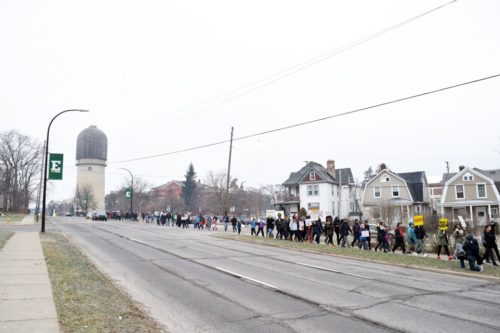
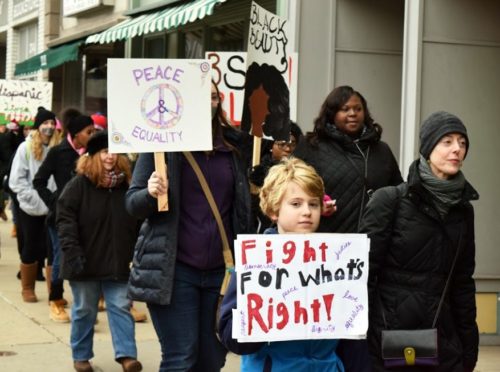
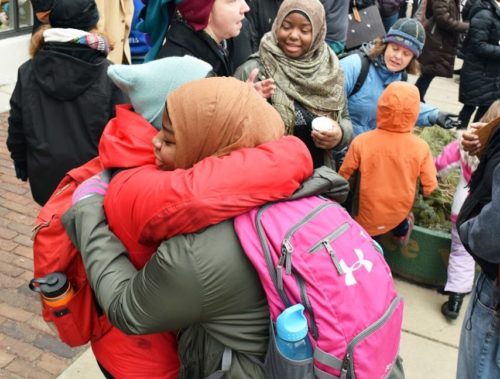
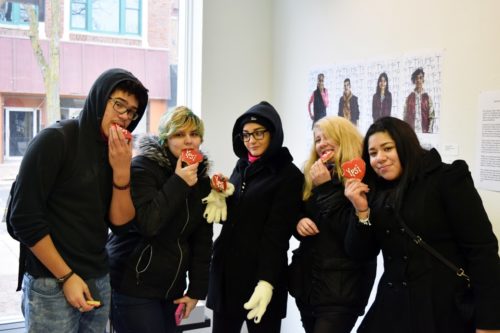

[That last image is of the speaking Frederick Douglass statue that the students made. Just as I left the room to make room for others, who were waiting patiently outside in the cold, it was reciting the following line from the speech that Douglass had given 150 years earlier, to the day. “(O)ur government may at some time be in the hands of a bad man,” the statue of Douglass said in the voice of an Ypsi High student. It was a surreal moment.]
FOR THOSE OF YOU WHO HAVE NEVER TUNED IN TO THE SIX PACK BEFORE, HERE ARE THE DETAILS ON HOW TO LISTEN:
Unless you live inside the AM 1700 studio, chances are you won’t be able to pick the show up on your radio. As that’s the case, I’d recommend streaming the show online, which you can do either on the AM1700 website or by way of TuneIn.com.
And for those of you who aren’t yet familiar with the show, and need to get caught up, you can listen to the entire archive on iTunes.
And do call us if you have a chance. We love phone calls. So please copy down this number and slide it into your sock – 734.217.8624 – and call us this Saturday evening. The show is nothing without you.
One last thing… If you’d like to tell your friends and neighbors about the program, feel free to share the Facebook event listing.
And, here, thanks to AM 1700 senior graphic designer Kate de Fuccio, is this week’s poster, in case any of you want to print copies and leave them at one of your favorite highway rest areas.
